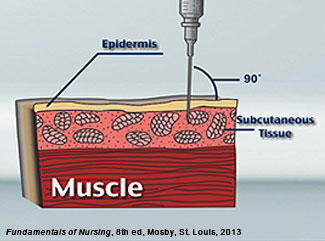Introduction to Subcutaneous Injections

Giving a Subcutaneous Injection (Shot)
There are persons who take medicines by injection (a shot). One type of injection is a subcutaneous (sub-q-tā-nē-us) or “under the skin” injection. A subcutaneous injection involves placing medicine into the loose fatty layer between the skin and muscle, where there are few blood vessels. A subcutaneous injection is easy to give and generally not painful.
When you give subcutaneous injections, you want to learn how to give an injection safely to be sure the medicine works as it should and to avoid injury to the person you care for. It is common for people with the following health conditions to receive subcutaneous injections:

- Diabetes
- People at risk for blood clots – for example after hip surgery
- Osteoporosis
- Multiple Sclerosis
This lesson will explain the reasons for giving subcutaneous injections, how to fill a syringe, signs to look for after giving a medicine, and how to give an injection correctly.
Here is Tina’s story

I help take care of my 62 year old sister, Louisa. She has had diabetes for many years and takes insulin. Louisa’s vision is not good enough for her to give herself a shot. She does not hold the syringe as well and she cannot see the dose on the syringe. I give her a shot each morning before breakfast and then she gets another shot before her evening meal. I was so afraid the first time I gave Louisa a shot, because I thought I would hurt her. She really helped and encouraged me that it would be easy to do. She was right. Louisa has had so many shots; she hardly feels them anymore. My biggest problem now is being at home to give her shot on time. That is really important for her.